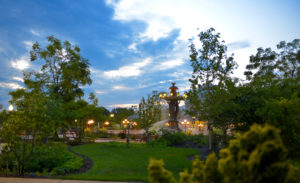
Bartholdi Park, at the United States Botanic Garden, is “an island of green” where every year over a million tourists, workers and a surprising diversity of birds and pollinators come to find respite from the stresses of the city.
Named for the French sculptor Frédéric Auguste Bartholdi, who is most famous as the sculptor of the Statue of Liberty, Bartholdi Park features his “Fountain of Light and Water” in the center.
A demonstration garden since 1932, the recent renovation is a showcase of how sustainable gardening can be beautiful as well as beneficial for both humans and the environment. Most recently, it achieved SITES Gold Certification for its sustainability strategies and is the first project in Washington, D.C. to be certified under the SITES Version Two Rating System.
The SITES program provides guidance, assistance and certification to ensure sustainable design and development principles to better serve communities and the environment. The Bartholdi Park project focused on SITES’ key areas: water, soil, plants, materials and human health.
Water: Ten rain gardens capture 100 percent of rainfall and allow it to soak into the ground, diverting runoff from D.C.’s combined sewer system. The rain gardens can accept up to 4,000 cubic feet of water in a 24-hour storm event – equivalent to 256 bathtubs of water. The project also used permeable paving and reduced the amount of impervious surface.
Soil: During renovation, topsoil was removed and saved off-site, amended with organic compost and returned to the park for the new plantings. In areas where plants were saved, the soil was also protected from compaction.
Plants: The gardens showcase plants native to the Mid-Atlantic region and a collection of edible plants in permanent and seasonal plantings in a new kitchen garden. The project team was able to save multiple large trees and shrubs on-site, while other plants were reused on Capitol Hill and in D.C. Public Schools.
Materials: Existing concrete sidewalks were crushed and then used as the base layer under the new sidewalks. Previous stone walls were disassembled and their stones were reused in the new walls for the raised kitchen garden. For the park’s locally sourced furniture, a Virginia company built seating and tables from white oaks that had fallen naturally during a storm.
Human Health: The park connects people to nature through programming that includes yoga and nature-in-motion walks. Additional seating, a water fountain and bicycle parking were added. The creation of the American Veterans Disabled for Life Memorial next door to the park presented an opportunity to collaborate with the National Park Service, and educational and therapeutic programs for veterans and active duty soldiers were developed and now use this space.
For more information, visit www.USBG.gov.
BY Sheila Wickouski

